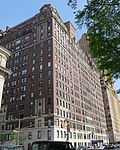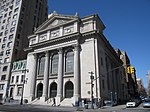The Dakota, also known as the Dakota Apartments, is a cooperative apartment building at 1 West 72nd Street on the Upper West Side of Manhattan in New York City, United States. The Dakota was constructed between 1880 and 1884 in the Renaissance Revival style and was designed by Henry Janeway Hardenbergh for businessman Edward Cabot Clark. The building was one of the first large developments on the Upper West Side and is the oldest remaining luxury apartment building in New York City. The building is a National Historic Landmark and has been designated a city landmark by the New York City Landmarks Preservation Commission. The building is also a contributing property to the Central Park West Historic District.
The Dakota occupies the western side of Central Park West between 72nd and 73rd Streets. It is largely square in plan and built around a central "I"-shaped courtyard, through which all apartments are accessed. Formerly, there was a garden to the west of the Dakota, underneath which was a mechanical plant serving the Dakota and some adjacent row houses. The facade is largely composed of brick with sandstone trim and terracotta detailing. The main entrance is a double-height archway on 72nd Street, which leads to the courtyard. The building's design includes deep roofs with dormers, terracotta spandrels and panels, niches, balconies, and balustrades. Each apartment at the Dakota had a unique layout with four to twenty rooms. The apartments were divided into quadrants, each of which had a stair and an elevator for tenants, as well as another stair and another elevator for servants.
Clark announced plans for an apartment complex at the site in 1879 and work began in late October 1880. The building was not given its name until mid-1882, and Clark died before the Dakota was completed in October 1884. The Dakota was fully rented upon its completion. The building was managed by the Clark family for eight decades and remained largely unchanged during that time. In 1961, the Dakota's residents bought the building from the Clark family and converted it into a housing cooperative. The Dakota has historically been home to many artists, actors, and musicians, including John Lennon, who was murdered outside the building in 1980.











